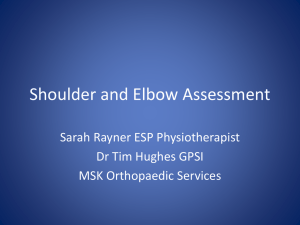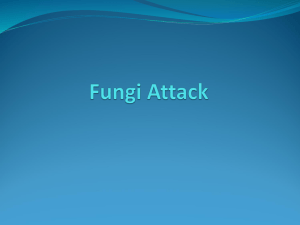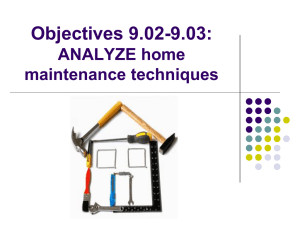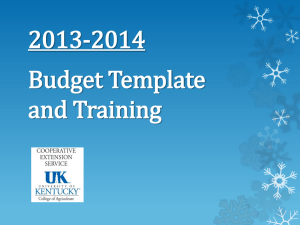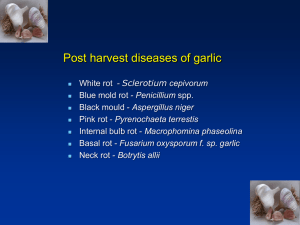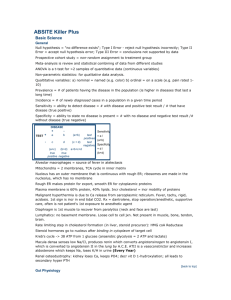SHOULDER PATHOLOGIES
advertisement
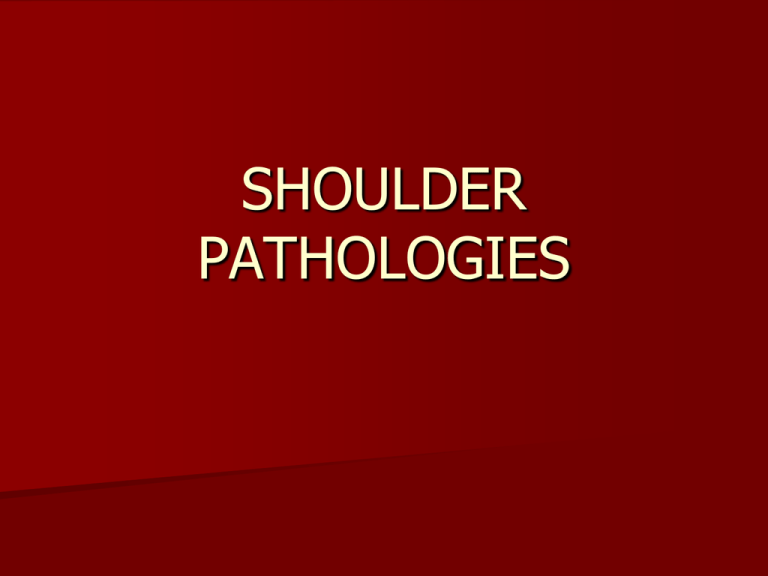
SHOULDER PATHOLOGIES IMPINGEMENTS PRIMARY- outlet obstruction (AC osteophyte, thickened bursa esp in RA, swelling/Ca deposits on RC tendon, #humerus, hooked acromions) SECONDARY- instability or muscle weakness (capsular lax/tightness, mm fatigue, imbalance force couples, spinal stiffness) ROTATOR CUFF TEARS STAGE 1 STAGE 2 STAGE 3>40yrs STAGE 4tears) reversible edema, <25yrs fibrosis + tendinitis 25-40yrs bony spurs + tendon ruptures shoulder arthropathy (4% cuff CLASSIFICATION SHOULDER DYSFNXS GROUP 1- impingement >35yrs GROUP 2- impingement + instability < 35yrs GROUP 3- impingement + instability born loose (have mm control if just hypermobile) GROUP 4 anterior instability torn loose IMPINGEMENTS DEEP IMPINGEMENTS – inside of mms impinged, try relocation test, if pain improves, then likely deep/SLAP. More likely to result in eventual SLAP lesion. weakening and laxity anterior structuresrepeated anterior/superior translation HH with HF and overhead- shortening post capsule- undersurface cuff tear- SLAPcomplete RC tear IMPINGEMENTS- TESTS NEERS- forced elevation of humerus whilst holding other hand on top shoulder girdle HAWKINS- 90 flexion and forcibly internally rotated (support on top shoulder girdle) INSTABILITY TESTS GROSS ANTERIOR INSTABILITY- apprehension POSTERIOR INSTABILITY- post instab test INFERIOR INSTABILITY- sulcus test SUBTLE DRAWER- load and shift tests ANTERIOR INSTAB- relocation INTERNAL IMPINGEMENT- relocation ANTERIOR INSTABILITY HILL SACHS DEFECT- posterior lateral HH strikes rim of glenoid at time of disloc BANKHART LESION- avulsion capsule and labrum from glenoid (traumatic avulsion) Both common with anterior instability In 90 abd, incr ext rot, decr int rot (and if int rot tight, will use scap protrxn thus vicious cycle) ROTATOR CUFF TEARS STAGE 1- oedema STAGE 2- tendinosis STAGE 3- tear Active mvts such as an arc of pain, HBB and HF decr and decr EOR flex are not indicative of one or the other stagegeneral RC TEARS SMALL TEARS- often missed in young people, only picked up when, despite other S&S improving, lat rot remains weak LARGE TEARS- generalized weakness and night pain ROTATOR CUFF TEARS 3 SIGNS: 1. POSTERIOR CUFF TIGHTNESS 2. EXT ROT 90/90 WEAKNESS 3. SCAPULAR DYSRHYTHMIA ROTATOR CUFF TEARS MISINTERPRETATIONS: - ABDUCTION STRONG BUT EXT ROT WEAK: Supraspin tear (for abd you need deltoid and RC, if strong enough, you wont pick it up- RC substitutes) - INTERNAL ROT- poor test, unlikely - EMPTY CAN TEST - ISOLATING EXT + INT CUFF MMS ROTATOR CUFF TEARS: MISINTERPRETATION Complex interaction shoulder synergists - Interdigitation rotator cuff near insertion - Tear size only really indicated by strength of Ext Rot (statically tested, resistance), is inversely prop and tests post cuff w no other mm substit Testing Abd and Int Rot appear to have very little clinical value in tears RC TEAR- RESISTED STATIC EXT ROT STRONG EXT ROT- Rx conservatively WEAK EXT ROT- investigate further (ultrasound) STRENGTH GOOD, BUT DECR ROM ALL DIRECTIONS- frozen shoulder/capsule (COMMON IN DIABETICS) SLAP LESIONS - - ‘SLAP’ = SUPERIOR LABRAL INJURIES: SUPERIOR LABRUM ANTERIOR POSTERIOR Biceps tendon also attaches to ant, post + sup labrum Usually SLAP diagnosed by exclusion and arthroscopy ‘dead arm syndrome’: weakness and numbness with overhead activities SLAP- HOW? - - Fall outstretched hand in abd Direct blow to shoulder TRACTION INJURY Subluxation or dislocation Repetitive overhead activities Lifting heavy objects Sudden violent biceps contraction…. SLAP- HOW?? - Repeated eccentric biceps contraction (deceleration) - TESTS: O’BRIENS CRANKS 1. 2. Arthroscopy confirms it AT RISK FOR SLAP LESIONS Ppl with posterior type II SLAP and internal impingement pre-injury Tight posterior capsule, anterior instability with decr int rot, incr ext rot (when doing ext rot, biceps in line w labrum, w incr ext rot labral disruption occurs, also pinching inf RC with the protrxn of the scapula (internal impingement). TIGHT POST CAPSULE, POOR SCAP CONTROL SLAP LESIONS- S&S GIRD (loss of int rot, incr ext rot) SICK scapula (abducted, ext rot, tipped anteriorly) Instability, RCS, biceps pathology Posterior pain Incr pain w throwing and lying on it Popping, locking, grinding, catching, need to move ?decr ROM and strength? SLAP LESION TESTS RELOCATION TEST- 90/90 pain incr w ext rot and pa on HH ACTIVE COMPRESSION TEST/O’BRIENS90 flex, 15 add, int rot, pt flexes and abd against R. Incr pain +, decr w ext rot.. CRANK TEST- 90 abd, axial load applied whilst slowly taken into int rot. + if catching or grinding pain BICEPS TESTS SPEEDS TEST- flex sh against R with elbow extended and hand fully supinated YERGASONS TEST- sh neutral, elbow 90 flex, resist supination from full pronation CALCIFYING TENDINITIS/BURSITIS Pain over deltoid area Arc of pain Decr ROM Night pain Atrophy REST, NSAID, AVOIS IMPINGEMENT POSITIONS, GENTLE ROM, AVOID HEAT GENERAL Anterior pain often local pathology Posterior pain: inside impingement or referred from Cx or Tx Watch out for distal anaes/paraesthesia Pattern of movement gives vital clues Slipping, popping/snapping, clicking/jamming/catching, dead arm: INSTABILITY OR LABRAL TEAR Crepitus- RC and AC joint Grinding- OA GENERAL- KIBLER KINETIC CHAIN Check your lower limbs, backs, knees, ankles, etc. Usually there is a problem in the opposite leg to the painful shoulder (esp with medial rotation of the hip). Check one leg balance, squats, joint ROM LLs, core stability etc Never forget Lats Dorsi- major reason for decr int rot and incr protrxn scap CERVICAL SPINE C4-6 ULTT MOBILITY AND HEAD POSITION LEV SCAP! R1 AND SCALENAE! TX SPINE AND COSTOVERT!!! QUICK ESCAPE NO TRANSLATOR 1. 2. 3. 4. 5. 6. Watch undress Assess posture- not just shoulder Watch carefully bilat and unilat abduction short or long lever Decide whats weak/hyperactive (remember stabilizers and movers) Palpate all suspected mms and release Test posterior capsule and stretch QUICK ESCAPE NO TRANSLATOR 1. 2. 3. 4. 5. 6. Release and needle mms Stretch capsule Mobilize Tx and Cx if needed Strap- various ways Setting of scap, turning on cuff ex’s and core stability ex’s (NO RESISTANCE OR LARGE MVTS!), neck stretches Kinetic handling!!!!!!!!!!!!!!
